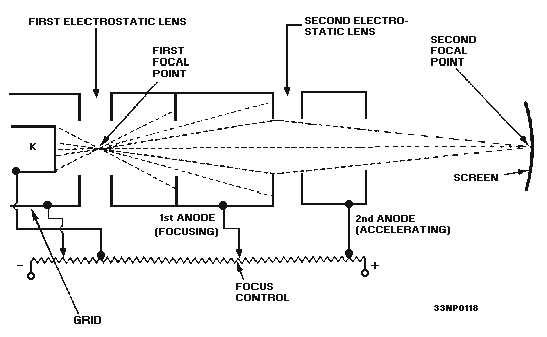6-3
lenses bend light rays. The first electrostatic lens cause the electrons to cross at the first focal point within
the field. The second lens bend the spreading streams and return them to a new, second focal point at the
CRT.
Q-3. Why are the electrostatic fields between the electron gun elements called lenses?
Figure 6-2.—Formation of an electron beam.
Figure 6-2 also shows the relative voltage relationships on the electron-gun elements. The cathode
(K) is at a fixed positive voltage with respect to ground. The grid is at a variable negative voltage with
respect to the cathode. A fixed positive voltage of several thousand volts is connected to the second
(accelerating) anode. The potential of the first (focusing) anode is less positive than the potential of the
second anode. The first anode can be varied to place the focal point of the electron beam on the screen of
the tube. Control-grid potential is established at the proper level to allow the correct number of electrons
through the gun for the desired image intensity.
Q-4. What is the function of the second anode?
ELECTRON BEAM-DEFLECTION SYSTEM
The electron beam is developed, focused, and accelerated by the electron gun. The beam appears on
the screen of the CRT as a small, bright dot. If the beam is left in one position, the electrons will soon
burn away the illuminating coating in that one area. To be of any use, the beam must be able to move. As
you have studied, an electrostatic field can bend the path of a moving electron.
As you have seen in the previous illustrations, the beam of electrons passes through an electrostatic
field between two plates. You should remember that electrons are negatively charged and that they will be
deflected in the direction of the electric force (from negative to positive). This deflection causes the
electrons to follow a curved path while in the electrostatic field.



